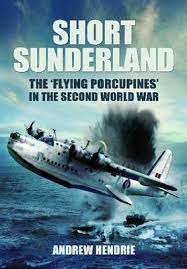By Andrew Hendrie; Pen and Sword, Barnsley, UK, (2022). (Reprint)
Reviewed by Capt. Richard Dick, USN (Ret.)
Andrew Hendrie’s Short Sunderland is a comprehensive operational portrait of the most famous British World War II maritime patrol aircraft. The author’s impressive research briefly covers the aircraft’s development, entry into service, production, and modification, and particularly its operational service around the world during and after World War II. Hendrie reviews every theater in which the aircraft served and all of its users (British, Australian, Canadian, New Zealand, and Norwegian). He includes every U-boat sinking in which the aircraft participated, air to air combat, air sea rescues, and maritime reconnaissance.
While the author writes about the development of the Sunderland and the significant modifications to the type during its production and service, this book is not primarily about the aircraft. William Green’s Flying Boats in the series War Planes of the Second World War and the Sunderland chapter in Shorts Aircraft Since 1900 by C.H. Barnes provide more focused technical discussions. Rather, Hendrie spends his time looking at the ways the crews employed the aircraft, especially in its most famous role- hunting German submarines in the Atlantic.
Shorts Brothers responded to a 1933 specification from the Air Ministry for a general purpose four-engine flying boat, choosing to springboard from the company’s work in developing the Empire Class commercial flying boat. By 1939, the four Sunderland squadrons provided RAF Coastal Command’s only long-range reconnaissance capability. As such, Sunderlands found themselves searching for German surface raiders, hunting submarines (despite initially lacking appropriate sensors or weapons), and rescuing survivors adrift at sea. Initially armed with only seven .303 caliber machine guns for defense, the pressure of operations (especially in the Bay of Biscay in 1942-1944) eventually saw some Sunderlands bristling with 18 machine guns (.303 and .50). Even the fighter versions of the German Junkers 88 treated individual Sunderlands with respect, especially after a June 1943 encounter in which Sunderland N/461 fought off eight Ju-88s, claiming three and damaging two others. While formidably armed, the Sunderland suffered from some costly air combat vulnerabilities, including the extensive hydraulic lines required for the power turrets (vulnerable to enemy fire) and the persistent use of .303 caliber guns, virtually guaranteeing the enemy an advantage in firing range and hitting power.
By mid-1943, Sunderlands were carrying effective search radars, low level bombsights, acoustic homing torpedoes, and Torpex-filled depth charges. Upgrades to the forward firing machine gun armament kept the Sunderland competitive even when U-boats with augmented anti-aircraft armament began staying on the surface to fight it out with ASW aircraft. By the end of the war, Sunderlands had participated in the sinking or damaging of about 56 German and Italian submarines. Postwar, the aircraft conducted maritime reconnaissance (pending the arrival of the Avro Shackleton), Arctic exploration, and humanitarian operations, including the Berlin Airlift. The last Sunderland remaining in service flew with the Royal New Zealand Air Force until about 1967.
The author has written a serviceable, comprehensive, and at times gripping, history of the Flying Porcupine. The photographs are extensive and well-chosen, although they would have benefited from a larger publication format with better definition. The appendices appear well researched and take advantage of recent scholarship.
Andrew Hendrie served in the Royal Air Force in World War II, completing a tour in Lockheed Hudsons, testing newly delivered Sunderlands, and beginning another operational tour in Vickers Wellingtons. After the Japanese surrender, he joined the Royal Air Force Volunteer Reserve and, after 1980, began a career as an aviation historian, specializing in maritime patrol aircraft and operations. Hendrie published works on RAF Coastal Command, Lockheed Hudsons, Consolidated Catalinas, and Short Sunderlands. He passed away in 2004.
Captain Dick is a retired submariner; he also served over 29 years in the defense intelligence community.
Andrew Hendrie served in the Royal Airforce during the Second World War, joined the reserve after the war, and, in 1980, began a career as an aviation historian. He passed away in 2004.
Short Sunderland: the “Flying Porcupines” in the Second World War. By Andrew Hendrie; Pen and Sword, (Barnsley, UK: 2022). (Reprint)


